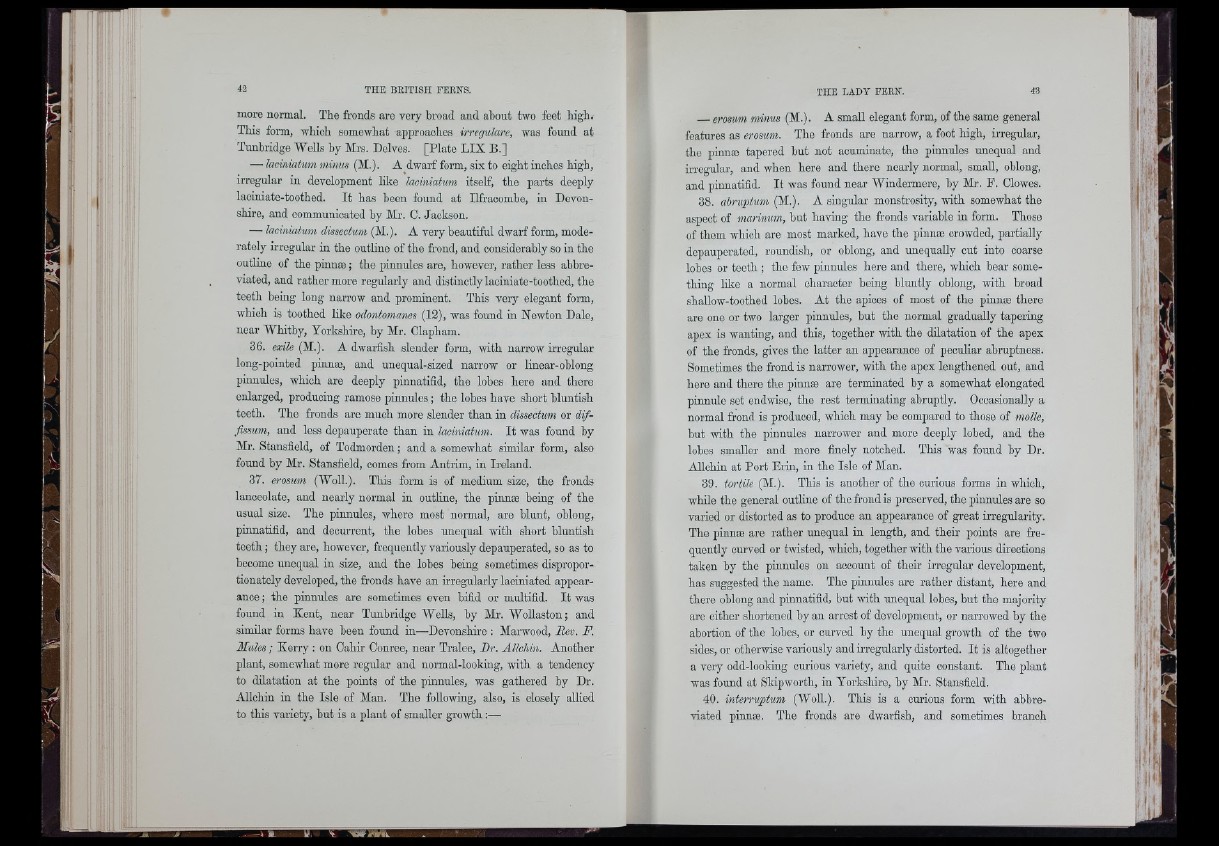
more normal. The fronds are very broad and about two feet high.
This form, which somewhat approaches irreguläre, was found at
Tunbridge WeUs by Mrs. Delves. [Plate LIX B.]
— laciniatum minus (M.). A dwarf form, six to eight inches high,
irregular in development lilco laciniatum itself, the parts deeply
laoiniate-toothed. It has been found at Ilfracombe, in Devonshire,
and communioated by Mr. 0. Jackson.
— laciniatum dissectum (M.). A very beautiful dwarf form, moderately
irregular in the outline of the frond, and considerably so in the
outline of the pinnæ ; the pinnules are, however, rather less abbreviated,
and rather more regularly and distinctly laoiniate-toothed, the
teeth being long narrow and prominent. This very elegant form,
which is toothed like odontomanes (12), was found in Newton Dale,
near Whitby, Yorkshire, by Mr. Clapham.
36. exile (M.). A dwarfish slender form, with narrow irregular
long-pointed pinnæ, and unequal-sized narrow or linear-oblong
pinnules, which are deeply pinnatifid, the lobes here and there
enlarged, producing ramose pinnules ; the lobes have short bluntish
teeth. The fronds are much more slender than in dissectum or dif-
fissum, and less depauperate than in laciniatum. It was found by
Mr. Stansfleld, of Todmorden ; and a somewhat similar form, also
found by Mr. Stansfleld, comes from Antrim, in Ireland.
37. erosum (WolL). This form is of medium size, the fronds
lanceolate, and nearly normal in outline, the pinnæ being of the
usual size. The pinnules, where most normal, are blunt, oblong,
pinnatifid, and decurrent, the lobes unequal with short bluntish
teeth ; they are, however, frequently variously depauperated, so as to
become unequal in size, aud the lobes being sometimes disproportionately
developed, tbe fronds have an irregularly laoiniated appearance
; the pinnules are sometimes even bifid or multifid. It was
found in Kent, near Tunbridge WeUs, by Mr. Wollaston; and
similar forms have been found in—Devonshire : Marwood, Bev. F.
Mules ; Kerry : on Cahir Conree, near Tralee, Br. Allchin. Another
plant, somewhat more regular and normal-looking, with a tendency
to dilatation at the points of the pinnules, was gathered by Dr.
Allchin in the Isle of Man. The following, also, is closely aUied
to this variety, hut is a plant of smaller growth :—
— erosum minus (M.). A smaU elegant form, of the same general
features as erosum. The fronds are narrow, a foot high, irregular,
the pinnæ tapered but not acuminate, the pinnules unequal and
irrco-ular, and when here and there nearly normal, small, oblong,
and pinnatifid. It was found near Windermere, by Mr. F. Clowes.
38. abruptum (M.). A singular monstrosity, with somewhat the
aspect of marinum, hut having the fronds variable in form. Tboso
of them which are most marked, have the pinnæ crowded, partially
depauperated, roundish, or oblong, and unequally out into coarse
lobes or teetb ; the few pinnules here and there, which bear something
like a normal character being bluntly oblong, with broad
shallow-tootbed lobes. At tbe apices of most of the pinnæ there
are one or two larger pinnules, but the normal gradually tapering
apex is wanting, and this, together with the dilatation of the apex
of the fronds, gives the latter an appearance of peculiar abruptness.
Sometimes the frond is narrower, vrith the apex lengthened out, and
here and there the pinnæ are terminated by a somewhat elongated
pinnule set endwise, the rest terminating abruptly. Occasionally a
normal frond is produced, which may be compared to those of molle,
but with the pinnules narrower and more deeply lobed, and the
lobes smaller and more finely notched. This was found by Dr.
Allchin at Port Erin, in the Isle of Man.
39. tortile (M.). This is another of the curious forms in which,
while the general outline of the frond is preserved, the pinnules are so
varied or distorted as to produce an appearance of great irregularity.
The pinnæ aro rather unequal in length, and their points are frequently
curved or twisted, which, together with the various directions
taken by tbe pinnules on account of their irregular development,
has suggested the name. The pinnules are rather distant, here and
there oblong and pinnatifid, but with unequal lobes, but tbe majority
are either shortened by an arrest of development, or narrowed by the
abortion of the lobes, or curved by the unequal growth of the two
sides, or otherwise variously and irregularly distorted. It is altogether
a very odd-looking curious variety, and quite constant. The plant
was found at Skipworth, in Yorkshire, by Mr. Stansfleld.
40. interruptum (WolL). This is a curious form with abbreviated
pinnæ. The fronds are dwarfish, and sometimes branch
(fri
I
1 ,
11
'' •’'fi f